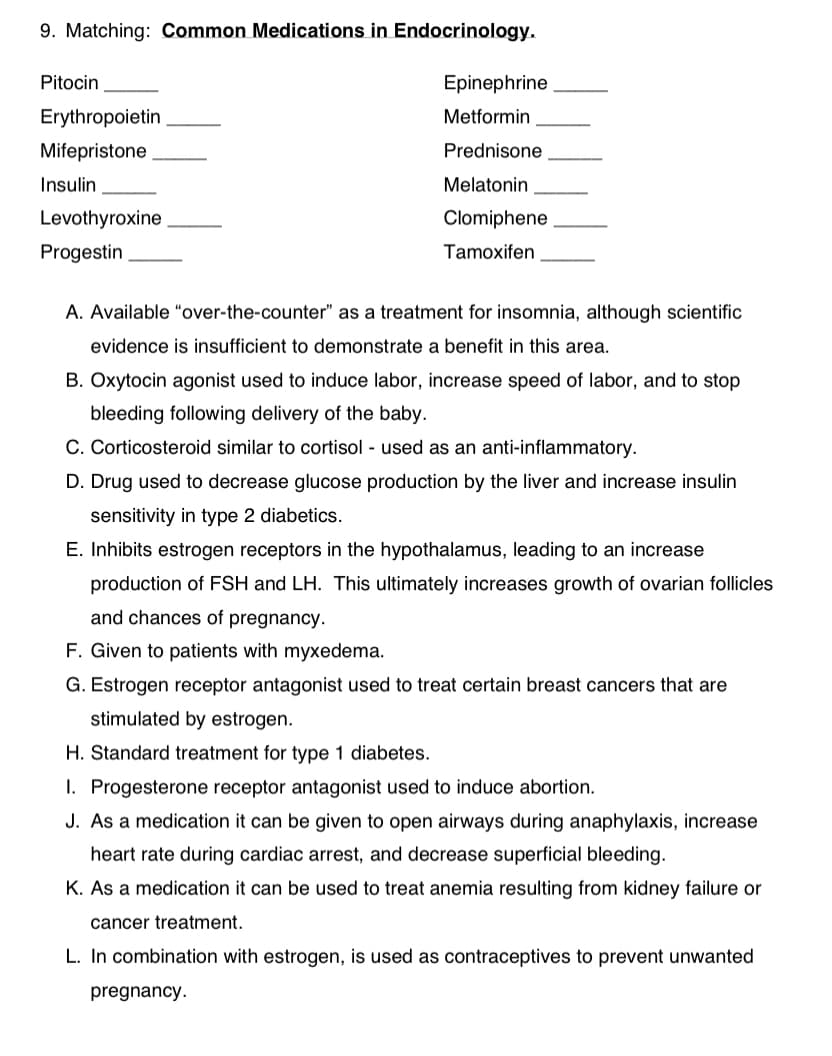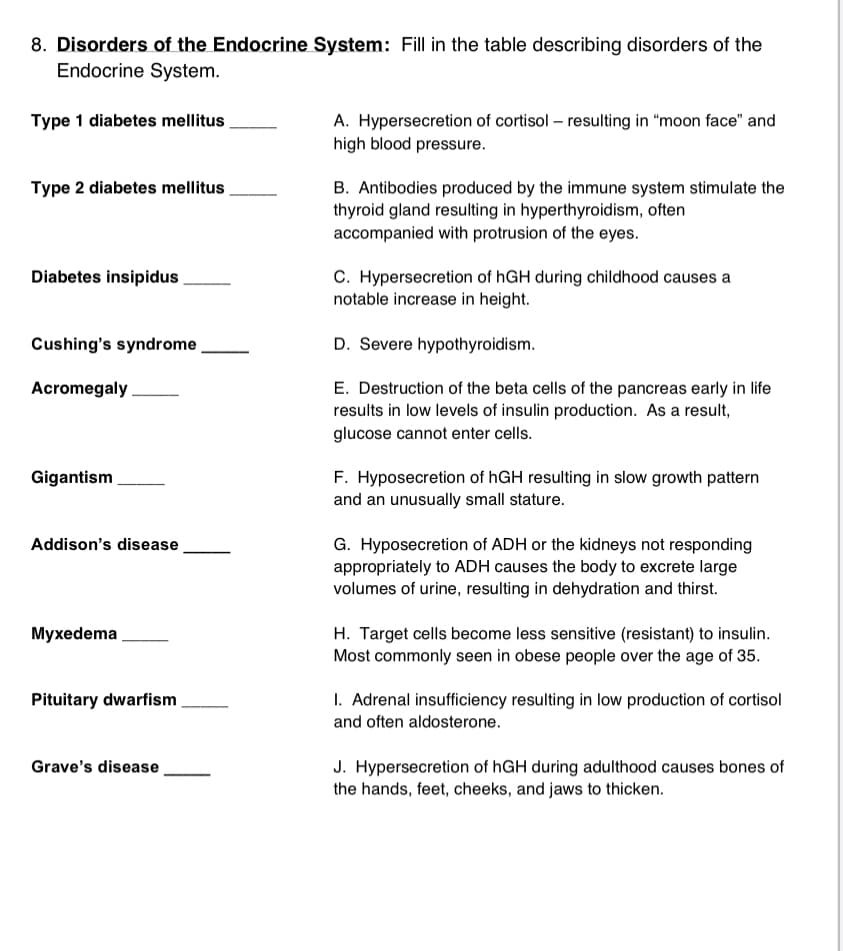9. Matching: Common Medications in Endocrinology. Pitocin Epinephrine Erythropoietin Metformin Mifepristone Prednisone Insulin Melatonin Levothyroxine Clomiphene Progestin Tamoxifen A. Available "over-the-counter" as a treatment for insomnia, although scientific evidence is insufficient to demonstrate a benefit in this area. B. Oxytocin agonist used to induce labor, increase speed of labor, and to stop bleeding following delivery of the baby. C. Corticosteroid similar to cortisol - used as an anti-inflammatory. D. Drug used to decrease glucose production by the liver and increase insulin sensitivity in type 2 diabetics. E. Inhibits estrogen receptors in the hypothalamus, leading to an increase production of FSH and LH. This ultimately increases growth of ovarian follicles and chances of pregnancy. F. Given to patients with myxedema. G. Estrogen receptor antagonist used to treat certain breast cancers that are stimulated by estrogen. H. Standard treatment for type 1 diabetes. 1. Progesterone receptor antagonist used to induce abortion. J. As a medication it can be given to open airways during anaphylaxis, increase heart rate during cardiac arrest, and decrease superficial bleeding. K. As a medication it can be used to treat anemia resulting from kidney failure or cancer treatment. L. In combination with estrogen, is used as contraceptives to prevent unwanted pregnancy.
9. Matching: Common Medications in Endocrinology. Pitocin Epinephrine Erythropoietin Metformin Mifepristone Prednisone Insulin Melatonin Levothyroxine Clomiphene Progestin Tamoxifen A. Available "over-the-counter" as a treatment for insomnia, although scientific evidence is insufficient to demonstrate a benefit in this area. B. Oxytocin agonist used to induce labor, increase speed of labor, and to stop bleeding following delivery of the baby. C. Corticosteroid similar to cortisol - used as an anti-inflammatory. D. Drug used to decrease glucose production by the liver and increase insulin sensitivity in type 2 diabetics. E. Inhibits estrogen receptors in the hypothalamus, leading to an increase production of FSH and LH. This ultimately increases growth of ovarian follicles and chances of pregnancy. F. Given to patients with myxedema. G. Estrogen receptor antagonist used to treat certain breast cancers that are stimulated by estrogen. H. Standard treatment for type 1 diabetes. 1. Progesterone receptor antagonist used to induce abortion. J. As a medication it can be given to open airways during anaphylaxis, increase heart rate during cardiac arrest, and decrease superficial bleeding. K. As a medication it can be used to treat anemia resulting from kidney failure or cancer treatment. L. In combination with estrogen, is used as contraceptives to prevent unwanted pregnancy.
Human Anatomy & Physiology (11th Edition)
11th Edition
ISBN:9780134580999
Author:Elaine N. Marieb, Katja N. Hoehn
Publisher:Elaine N. Marieb, Katja N. Hoehn
Chapter1: The Human Body: An Orientation
Section: Chapter Questions
Problem 1RQ: The correct sequence of levels forming the structural hierarchy is A. (a) organ, organ system,...
Related questions
Question
100%

Transcribed Image Text:9. Matching: Common Medications in Endocrinology.
Pitocin
Epinephrine
Erythropoietin
Metformin
Mifepristone
Prednisone
Insulin
Melatonin
Levothyroxine
Clomiphene
Progestin
Tamoxifen
A. Available "over-the-counter" as a treatment for insomnia, although scientific
evidence is insufficient to demonstrate a benefit in this area.
B. Oxytocin agonist used to induce labor, increase speed of labor, and to stop
bleeding following delivery of the baby.
C. Corticosteroid similar to cortisol - used as an anti-inflammatory.
D. Drug used to decrease glucose production by the liver and increase insulin
sensitivity in type 2 diabetics.
E. Inhibits estrogen receptors in the hypothalamus, leading to an increase
production of FSH and LH. This ultimately increases growth of ovarian follicles
and chances of pregnancy.
F. Given to patients with myxedema.
G. Estrogen receptor antagonist used to treat certain breast cancers that are
stimulated by estrogen.
H. Standard treatment for type 1 diabetes.
I. Progesterone receptor antagonist used to induce abortion.
J. As a medication it can be given to open airways during anaphylaxis, increase
heart rate during cardiac arrest, and decrease superficial bleeding.
K. As a medication it can be used to treat anemia resulting from kidney failure or
cancer treatment.
L. In combination with estrogen, is used as contraceptives to prevent unwanted
pregnancy.

Transcribed Image Text:8. Disorders of the Endocrine System: Fill in the table describing disorders of the
Endocrine System.
Type 1 diabetes mellitus
A. Hypersecretion of cortisol – resulting in "moon face" and
high blood pressure.
B. Antibodies produced by the immune system stimulate the
thyroid gland resulting in hyperthyroidism, often
accompanied with protrusion of the eyes.
Type 2 diabetes mellitus
C. Hypersecretion of hGH during childhood causes a
notable increase in height.
Diabetes insipidus
Cushing's syndrome
D. Severe hypothyroidism.
E. Destruction of the beta cells of the pancreas early in life
results in low levels of insulin production. As a result,
glucose cannot enter cells.
Acromegaly.
F. Hyposecretion of hGH resulting in slow growth pattern
and an unusually small stature.
Gigantism
Addison's disease
G. Hyposecretion of ADH or the kidneys not responding
appropriately to ADH causes the body to excrete large
volumes of urine, resulting in dehydration and thirst.
Myxedema
H. Target cells become less sensitive (resistant) to insulin.
Most commonly seen in obese people over the age of 35.
Pituitary dwarfism
I. Adrenal insufficiency resulting in low production of cortisol
and often aldosterone.
Grave's disease
J. Hypersecretion of hGH during adulthood causes bones of
the hands, feet, cheeks, and jaws to thicken.
Expert Solution
This question has been solved!
Explore an expertly crafted, step-by-step solution for a thorough understanding of key concepts.
This is a popular solution!
Trending now
This is a popular solution!
Step by step
Solved in 3 steps with 1 images

Recommended textbooks for you

Human Anatomy & Physiology (11th Edition)
Anatomy and Physiology
ISBN:
9780134580999
Author:
Elaine N. Marieb, Katja N. Hoehn
Publisher:
PEARSON

Anatomy & Physiology
Anatomy and Physiology
ISBN:
9781259398629
Author:
McKinley, Michael P., O'loughlin, Valerie Dean, Bidle, Theresa Stouter
Publisher:
Mcgraw Hill Education,

Human Anatomy
Anatomy and Physiology
ISBN:
9780135168059
Author:
Marieb, Elaine Nicpon, Brady, Patricia, Mallatt, Jon
Publisher:
Pearson Education, Inc.,

Human Anatomy & Physiology (11th Edition)
Anatomy and Physiology
ISBN:
9780134580999
Author:
Elaine N. Marieb, Katja N. Hoehn
Publisher:
PEARSON

Anatomy & Physiology
Anatomy and Physiology
ISBN:
9781259398629
Author:
McKinley, Michael P., O'loughlin, Valerie Dean, Bidle, Theresa Stouter
Publisher:
Mcgraw Hill Education,

Human Anatomy
Anatomy and Physiology
ISBN:
9780135168059
Author:
Marieb, Elaine Nicpon, Brady, Patricia, Mallatt, Jon
Publisher:
Pearson Education, Inc.,

Anatomy & Physiology: An Integrative Approach
Anatomy and Physiology
ISBN:
9780078024283
Author:
Michael McKinley Dr., Valerie O'Loughlin, Theresa Bidle
Publisher:
McGraw-Hill Education

Human Anatomy & Physiology (Marieb, Human Anatomy…
Anatomy and Physiology
ISBN:
9780321927040
Author:
Elaine N. Marieb, Katja Hoehn
Publisher:
PEARSON